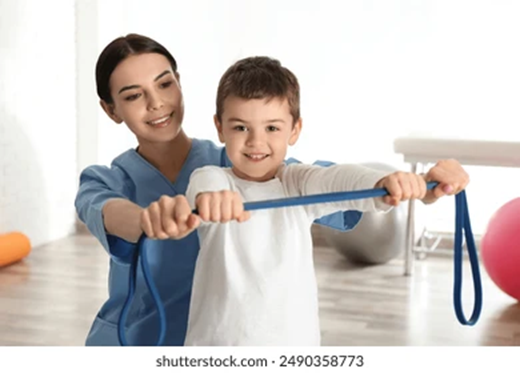
- 29 January 2025
- {{ views_count }} Views
- {{comments_count}} Comments
- {{rating_percentage}} % Ratings percentage
This site supports the ability to read text through highlighting
Alwaha for Child Development Services

The Role of Physiotherapy in Managing Hand Dysfunction in Children with Cerebral Palsy (CP)
Cerebral palsy (CP) is a group of permanent motor disorders caused by damage to the brain during development. Children with CP often exhibit varying degrees of muscle spasticity, weakness, and coordination problems. A significant issue in CP is hand dysfunction, which can affect a child's ability to perform essential daily activities. Physiotherapy is a cornerstone in the management of hand dysfunction in children with CP, helping to improve function, promote independence, and increase quality of life.
This article explores the role of physiotherapy in managing hand dysfunction in pediatric CP, focusing on various interventions, strategies, and evidence-based practices.
Understanding Hand Dysfunction in Cerebral Palsy
Hand dysfunction in CP can manifest in different ways, including spasticity, muscle weakness, lack of fine motor control, or abnormal postures that prevent the hands from functioning as intended. CP can affect one hand (hemiplegia) or both hands (diplegia or quadriplegia), with severity ranging from mild to profound. The following factors contribute to hand dysfunction in CP:
Hand dysfunction can impede a child’s ability to perform essential tasks such as feeding, writing, dressing, and playing. Early and effective intervention is crucial for improving hand function and maximizing independence.
The Role of Physiotherapy
Physiotherapists play a critical role in managing hand dysfunction in children with CP. The goals of physiotherapy are to improve motor function, enhance coordination, prevent deformities, and increase independence in daily activities. A physiotherapist uses a combination of therapeutic techniques, exercises, and assistive devices to promote functional hand use.
1. Neuromuscular Re-education
Physiotherapy helps children with CP relearn or improve the motor skills necessary for hand function. Neuromuscular re-education involves exercises that target motor planning, coordination, and muscle control. By stimulating the brain's plasticity, children can develop or refine their ability to perform hand movements.
Approaches:
2. Constraint-Induced Movement Therapy (CIMT)
For children with hemiplegic CP (affecting one side of the body), CIMT is an effective physiotherapy technique. This therapy involves constraining the unaffected hand and encouraging the use of the affected hand. The forced use of the weaker hand helps the brain reorganize itself and enhance motor skills in the affected limb.
Evidence-Based Success: CIMT has shown positive outcomes, particularly in improving functional use and dexterity of the affected hand, making it a cornerstone of therapy for hemiplegic CP.
3. Hand-Arm Bimanual Intensive Therapy (HABIT)
HABIT is a form of therapy designed to improve the use of both hands simultaneously, which is essential for many daily tasks. HABIT focuses on functional tasks that require the use of both hands, such as eating or dressing. Intensive, repetitive practice is key to improving the ability to use both hands together, enhancing hand coordination and overall function.
4. Botulinum Toxin (Botox) Injections and Physiotherapy
In cases where spasticity severely limits hand movement, Botox injections can be used to reduce muscle tone. When combined with physiotherapy, Botox can help improve the range of motion and allow for better participation in rehabilitation exercises. This combination approach can have significant benefits for children who have persistent spasticity despite traditional therapy.
5. Orthoses and Assistive Devices
Customized orthotic devices can provide stability, improve hand posture, and support motor control. These devices are especially beneficial in cases of contractures, where the range of motion is severely limited. Orthotics help prevent deformities, improve positioning, and allow for functional tasks.
Types of Orthotics:
Additionally, assistive devices such as modified utensils, writing aids, and buttonhooks can enable children to perform tasks independently.
6. Strengthening Exercises and Stretching
Strengthening exercises are essential for improving muscle strength and endurance in children with CP. Physiotherapists design exercise programs targeting the hand, wrist, and forearm muscles to improve grip strength and dexterity. Stretching exercises are used to increase flexibility and prevent joint contractures that may hinder hand movement.
Key Exercises:
7. Neurodevelopmental Treatment (NDT) or Bobath Concept
The Bobath Concept, also known as neurodevelopmental treatment, is an approach that focuses on normalizing movement patterns. Physiotherapists trained in NDT aim to facilitate the child’s ability to achieve functional hand movements by guiding and supporting proper posture and movement patterns. This approach is particularly helpful for children with spastic CP, as it helps to reduce abnormal muscle tone and improve functional movements.
Multi-Disciplinary Approach
The management of hand dysfunction in children with CP involves a collaborative, multidisciplinary approach. Physiotherapists work alongside occupational therapists, speech therapists, orthopedic specialists, and neurologists to provide a holistic treatment plan. Involving parents and caregivers in the therapy process is also crucial for reinforcing exercises and supporting the child in daily activities.
Collaboration with Occupational Therapists: Occupational therapists focus on improving fine motor skills and functional hand use, complementing the physiotherapy approach. Together, they ensure that children gain the necessary skills to perform tasks such as feeding, writing, and self-care.
Challenges and Considerations
Despite the advancements in physiotherapy, challenges remain in the management of hand dysfunction in CP. The degree of impairment varies widely, and some children may not achieve full independence in hand function, particularly if spasticity is severe. Additionally, children with CP often require long-term therapy to maintain or improve function, and access to appropriate services may be limited in some areas.
Free and Accessible References
These resources provide valuable insights into the physiotherapeutic management of hand dysfunction in CP, including detailed evidence-based practices and intervention strategies.
Comments({{ comments_count }})
{{ item.name }}
{{ item.created_at_format }}{{ item.message }}
Leave a Reply
Leave a Reply